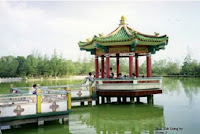Mbaru Niang is a traditional houses di Wae Rebo. One of the attractions of this village that is worldwide is the preserved traditional house in this village, Mbaru Niang. In the Manggarai language, Mbaru Niang means 'drum house'. Building this cone is built traditionally. It is called a drum house because one of the houses is used for storing sacred heirloom drums and gongs which are sacred media for communicating with ancestors.
Mbaru cone (kerucut) home in the village of Wae Rebo niang. Traditional house mbaru niang is very rare because only a few and only in villages remote indigenous Wae Rebo over the mountains.Mbaru niang cone with a height of about 15 meters. The roof of palm fiber or grass with a bamboo roof frame. The main poles using wood worok big and strong.Each mbaru niang housed six to eight families. Although not very large, the division of space in the mbaru niang show house functions as a living, to save the harvest, as well as to worship ancestors.At the first level is called lutur used as a place to live and hang out with family. The second level is called lobo form of an attic or a function for storing food and stuff everyday. The third level is called lentar to store seeds for food crops, such as corn, rice, and beans. The fourth level is called Lempa rae used to store food reserves that can be used when in an emergency due to crop failure. Five or top level called hekang code used to place offerings for ancestors.Wae Rebo Mbaru niang houses constructed by utilizing nature. Pole of wood, bamboo roof frame, roof of palm fiber.
Mbaru cone (kerucut) home in the village of Wae Rebo niang. Traditional house mbaru niang is very rare because only a few and only in villages remote indigenous Wae Rebo over the mountains.Mbaru niang cone with a height of about 15 meters. The roof of palm fiber or grass with a bamboo roof frame. The main poles using wood worok big and strong.Each mbaru niang housed six to eight families. Although not very large, the division of space in the mbaru niang show house functions as a living, to save the harvest, as well as to worship ancestors.At the first level is called lutur used as a place to live and hang out with family. The second level is called lobo form of an attic or a function for storing food and stuff everyday. The third level is called lentar to store seeds for food crops, such as corn, rice, and beans. The fourth level is called Lempa rae used to store food reserves that can be used when in an emergency due to crop failure. Five or top level called hekang code used to place offerings for ancestors.Wae Rebo Mbaru niang houses constructed by utilizing nature. Pole of wood, bamboo roof frame, roof of palm fiber.













